William Weekes, born in Port Elmsley, passed on in Saskatchewan: Some of his story
Touching through time and space.
In 1851, some years after their arrival from Ireland, Joseph Weekes and Jane (Fullerton) Weekes bought a farm on the edge of Port Elmsley and lived there with several of their children. About 130 years later, not knowing yet of their story, I bought the farm next door.
All my life I had known of the Weekes in Lombardy and pictured generations of them walking, working and playing there. Port Elmsley was, I imagined, another country far away, a place to which both Alan and I in more recent decades had moved as family pioneers. So the discovery of a significant chunk of the family being not only in the area but next door! came as a considerable surprise.
Recently my path crossed in another space with that of one of the Port Elmsley Weekes. Our time at the crossing point was just separated by 75 years or so.
It is striking that so many Weekes had itchy feet that propelled them throughout the continent and the world. This affliction continues in current generations, and in my early 20s I began my own travels. These days my job is to help prepare others to go on their journeys. Recently such a briefing took me to Regina, Saskatchewan and an encounter with the life of William Weekes.
My training program was taking place in the offices of the Prairie Farm Rehabilitation Administration, (the PFRA) which at the time of this writing is responsible for a project in Ethiopia, helping farmers capture water and manage land devastated by prolonged drought. I learned that the PFRA started in Canada with the same mandate in 1935, and that it was administered in its early years by the nearby Indian Head Experimental Farm. Indian Head. That name was already familiar. One of our number, William Weekes, died in Indian Head. The staff at the PFRA and the Saskatchewan Archives helped me picture the world in which William spent the last twenty years of his life.
Port Elmsley
When Joseph and Jane bought the Port Elmsley homestead (Concession 6, Lot 10, just in front of the present day subdivision of The Pines) they moved in with two of their children, Alexander the 4th born (age 25 in 1851) and James the 5th born (age 21in 1851). First born Joseph wasn't with the family, having joined the British army some years earlier. Second-born Edward Fullerton was already well established in Lombardy. Third born Charlotte had married James Conerty in 1842, when she was 21 years old. It isn't clear where John and Elizabeth, the youngest children, had gotten to.
Their son James (5th born) was already married, to Glasgow born Anna Smith. [We note here the challenges of getting accurate information after so many years. James' obituary says that he married in 1854, but the 1851 North Elmsley census notes that they were already together, with two children.] Their first two kids, John and James Jr, aged 3 and 2, were with them.
Joseph died a few years later, in 1854 at about the age of 77, and Jane died in 1863 at about the same age, transferring title of the land to James.
James and Ann had ten or eleven children in total, the last born being William, born sometime between 1879 and 1882. (A number of sources, including a gravestone in Carleton Place, indicate that he was born in 1882. However the 1881 North Elmsley census lists him as two years old.)
To Indian Head
According to James' death notice as printed in the newspaper, James lived on "the homestead" until 1875, when he moved into Port Elmsley (the centre of the village being a mile or so from the farm.) So William was born in the village rather than on the farm. He seems to have been a good student, and was listed in the honour rolls in the village school several times in 1889 and 1891.
In 1894 James and Ann moved with the family to Carleton Place. One of William's older brothers, James, had moved to Carleton Place while still in his teen years, at about the time the farm had been sold. He became a successful merchant in town. William was 12 or 15 years old when he made the move in the company of his parents. .
Sometime around 1906 William, then in his early twenties, left Carleton Place and headed west. His mother had died in 1897, and his Dad had died in 1901. The other kids in the family had either married or moved on, and he needed to be finding his own path in life. (His oldest brother John had gone to Montana, where he died years earlier. His brother Joseph had moved to Smiths Falls while a teenager, and there worked for Frost and Woods for many years as well as being a volunteer fire fighter. Among his other siblings, at least Alexander, Elizabeth and Charlotte moved to the mining boomtown of Cobalt although we aren't yet sure in what years.)
Why did he end up in Indian Head, Saskatchewan? Many were headed that way. The Canadian government was actively promoting migration to the west. In 1905 the Canadian government had created the new provinces of Saskatchewan and Alberta out of the former Northwest Territories. The CPR had spread track widely, and covered this corner of Saskatchewan. William's cousin, George Ogle Weekes, was employed with the CPR in Smiths Falls, and may have facilitated the move or encouraged William.
There was a lot of publicity about the new province of Saskatchewan. W. Richard Motherwell, P.C., who had been born in Perth, Ontario in 1860, became the first Minister of Agriculture in Saskatchewan in 1905. This would have been reported prominently in local papers, and must have added to the interest of a young man like William Weekes in checking out the new frontier. Motherwell went on to become the Dominion Minister of Agriculture from 1921 to 1930.
(At about the same time another Ontario family by the name of Baker moved to the same corner of Saskatchewan, close to Creelman, and Ola Baker (Tuck), Randy and Alan Weekes' maternal grandmother was born there.)
The Indian Head Experimental Farm (where William died) was one of five that had been established in various parts of Canada in 1887. One of the others was the Central Experimental Farm in Ottawa. Little agricultural research had been undertaken within Canada up until that time. There were a number of crop failures in the 1880s and it was realized that new farming methods and crop varieties were needed. Each regional Experimental Farm was to focus on the unique soils and climatic conditions of its own area.
The small town of Indian Head (200 people in 1887,) was on the CPR line, was imagined to be a centre of growth for agriculture and had already become a principal area for grain production. The new Experimental Farm was bought as a plot of 675 acres from an immense 50,000 acre farm belonging to William Robert Bell, originally a native of Brockville, Ontario.
By the time that William Weekes arrived in the area the Experimental Farm was well established with hundreds of varieties of wheat, barley, oats, peas, corn and root crops under test. New farming techniques were being tried, and by 1893 more than 110,000 trees had been planted at the farm in experimental windbreaks. There were also experiments with varieties of cattle, pigs, sheep and poultry. Clydesdale horses were introduced to the Farm and the Indian Head Clydes were famous for many years, right through the time of William's death in 1926.
The Farm had an extensive outreach. It sent exhibits to fairs around the world, and by 1905 train excursions brought hundreds of visitors to the farm. In 1905 almost 8,000 letters of inquiry were received and answered by the Farm. By 1912 that number had increased to 16,000 letters. It was a busy place.
We aren't sure at this point whether William spent all of his time in the west working at the Indian Head Experimental Farm or if he did other things. The Ontario death notice says "about 20 years ago Mr. Weekes [located] in Indian Head, where he was employed with the Dominion Experimental Farm and where he remained until claimed by death." The Saskatchewan paper reports "Wm. Weeks for a number of years has lived in the Indian Head district. Mr. Weekes had lately been employed at the Experimental Farm." We can only hope that correspondence or other records will emerge which will clarify what he did.
Both reports do clearly associate him in the last part of his life with the Experimental Farm, however.
Let us assume that he was working on the farm for at least a few years before his death. What was happening in his world?
By 1920 the Experimental Farms were 34 years old, and at a point of being under-appreciated by Parliament. In 1924 the Indian Head budget was cut by $125,000 and changes in the way of doing business were required. There was a large turnover in staff, with three Farm Superintendents in a six year period. Things did not run as smoothly as they had in earlier years.
Despite this, new varieties of crops were being tested, and by 1930 when rust epidemics became a very serious problem, four new varieties of early maturing, rust resistant wheat were available. The Dirty Thirties were approaching, and experiments had already begun with methods like plowless summer fallowing and the increased use of barnyard manure on crops. The role of trees continued to be valued and new varieties were being developed to deal with emerging disease, insect and weather challenges. 1925 marked the heaviest crop of crab apples on the farm ever. (Trees took on increasing importance, with a new arboretum established in 1928. In 2003 the arboretum is the principal focus of the Indian Head operation.)
The Clydesdale horses remained a feature of the Farm. In 1926 there were over 1 million horses in Saskatchewan and just 26,000 tractors. With depression and drought the number of tractors actually decreased in the 1930s. The Farm was dedicated to experimentation, however, and a CASE tractor was used to propel the Farm's first combine in 1927, the year after William's death. Shorthorn cattle were on the farm in the early 1920's, but in 1925 an Ayrshire herd was introduced, gradually taking over as the dominant breed. There were still swine, limited to Yorkshires by 1925. Interest in sheep was declining, with only Shropshires remaining in 1925, and these disappearing by the early 1930s. White Wyandotte chickens were the birds of choice at the time, though these were replaced by Barred Plymouth Rocks a few years later.
Even under the tightened budgets of the Farm some building continued, and a new dairy building was erected the summer William died.
It was a warm summer, but spirits in the community were high. The municipal council had run a contest and school children had succeeded in destroying 6100 gophers and collecting 4632 crows' eggs. Softball was popular and on Tuesday, July 6 the Experimental Farm team won against another local team despite its being the hottest day of the year, with the thermometer at the Farm registering 89 degrees in the shade. Work was underway to receive the local Agricultural Society on their annual tour and supper at the Farm on Thursday.
William wasn't feeling well that Tuesday. That evening, after supper, he was sitting talking with other Farm employees in the boarding house and suddenly collapsed. He passed away before medical help arrived. He was in his mid-forties.
He was taken to rest at the local undertaking parlor for a period, while his family in Cobalt and Carleton Place were notified. They were told that he had died of acute indigestion. His body was placed on the CPR train and by Saturday it was in Carleton Place. The funeral, attended by family and friends who traveled from Cobalt, Smiths Falls, Port Elmsley and Ottawa, was held on Sunday.
He shares a tombstone with his mother, father and a number of his siblings in Beckwith United Cemetery, just outside of Carleton Place.
__________________
Written by Randy Weekes, January 2003. Photos and information drawn from
the publication Indian Head Experimental Farm 1886-1986 (W.E. Johnson
& A. E. Smith, Research Branch, Agriculture Canada, Historical Series
No. 23, 1986 ISBN 0-662-14386-8), the book History of Indian Head and
District, (1984, ISBN 0-919781-26-8), microfiche copies of the Indian Head
newspaper, The News, and other research to date on the Weekes family.
William (Willie) was a good student as the following Honor Roll credits in the Perth Courier would indicate.
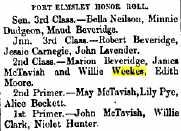
April 5, 1889
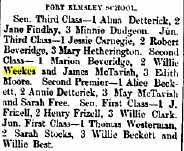
May 10, 1889
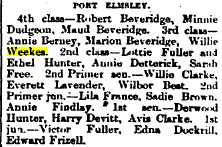
May 8, 1891
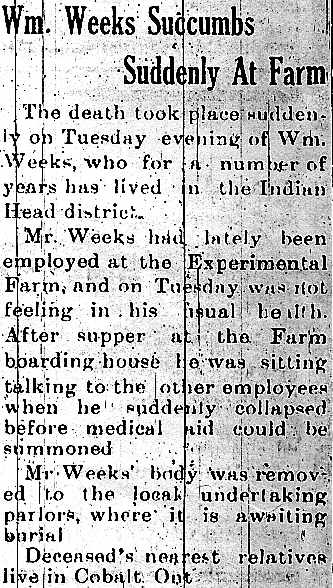
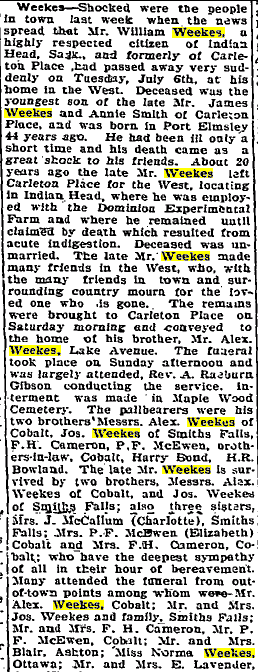
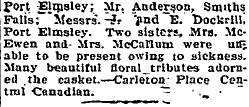
The following Indian Head photos were copied from and can be found in their original form in the book Indian Head Experimental Farm 1886-1986 (W. E. Johnson & A. E. Smith, Research Branch, Agriculture Canada, Historical Series No. 23, 1986)
1. Indian Head threshing team, sometime between 1906 and 1920. William may have been present.
2. Up until 1927, most work on the farm was done with horses.
3. Indian Head threshing team, 1923.
4. The first combine, 1927. William missed this by a year.
5. George Lang was office manager at Indian Head for many years. This photo was taken in 1927. It would be logical to assume that it was Lang who called William's relatives in Cobalt or Carleton Place to inform them of his death.